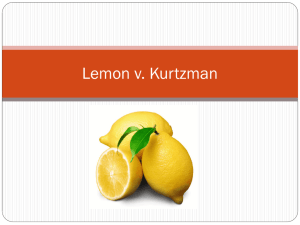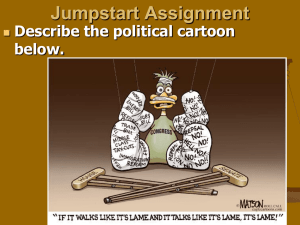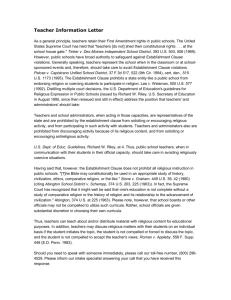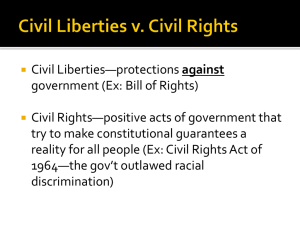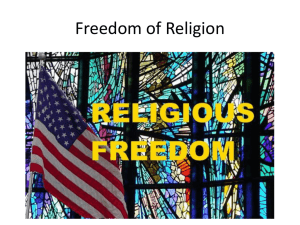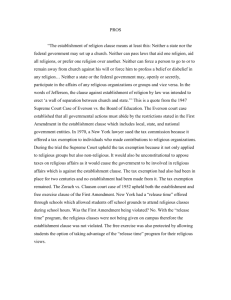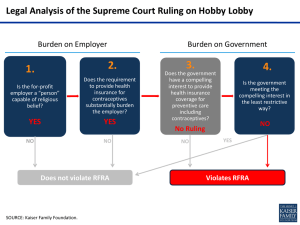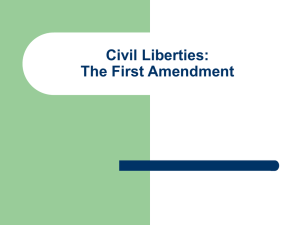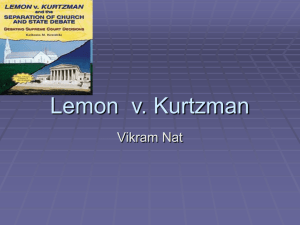B J C
advertisement
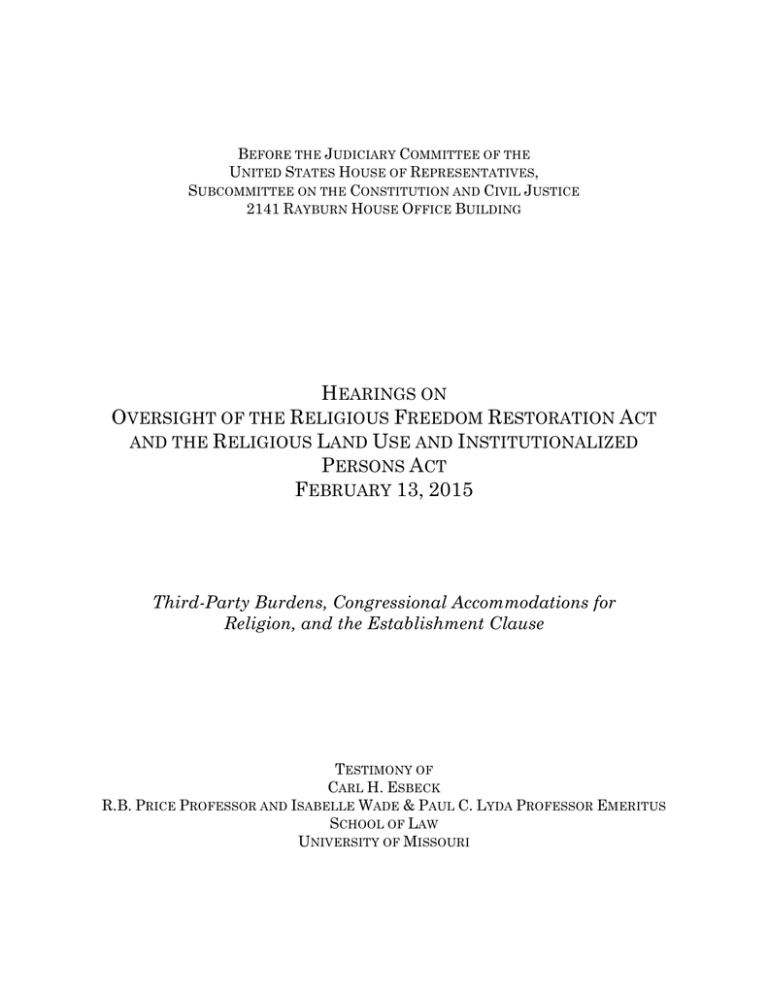
BEFORE THE JUDICIARY COMMITTEE OF THE UNITED STATES HOUSE OF REPRESENTATIVES, SUBCOMMITTEE ON THE CONSTITUTION AND CIVIL JUSTICE 2141 RAYBURN HOUSE OFFICE BUILDING HEARINGS ON OVERSIGHT OF THE RELIGIOUS FREEDOM RESTORATION ACT AND THE RELIGIOUS LAND USE AND INSTITUTIONALIZED PERSONS ACT FEBRUARY 13, 2015 Third-Party Burdens, Congressional Accommodations for Religion, and the Establishment Clause TESTIMONY OF CARL H. ESBECK R.B. PRICE PROFESSOR AND ISABELLE WADE & PAUL C. LYDA PROFESSOR EMERITUS SCHOOL OF LAW UNIVERSITY OF MISSOURI THIRD-PARTY BURDENS, CONGRESSIONAL ACCOMMODATIONS FOR RELIGION, AND THE ESTABLISHMENT CLAUSE QUESTION DISCUSSED Justice Ginsburg, dissenting in Burwell v. Hobby Lobby Stores, Inc., 134 S. Ct. 2751, 2787, 2790 n.8, 2802 n.25 (2014), wrote that when a statute seeks to accommodate a claimant’s religious beliefs or practices there must be no detrimental effects on third parties who do not share those beliefs. While it is unclear whether Justice Ginsburg was relying on the Establishment Clause as imposing this limitation on the power of Congress,1 some commentators argue that her thinking does rest on the Establishment Clause.2 It is of some importance whether these commentators are correct about the third-party burden rule being derived from the Establishment Clause. Although Justice Alito for the Court in Hobby Lobby squarely rejected the argument that third-party burdens categorically defeat requests for accommodations under RFRA (134 S. Ct. at 2781 n.37), he did not bring up the Establishment Clause (indeed, the government didn’t argue it). So these commentators promoting the third-party burden rule are able to maintain that nothing in Hobby Lobby contradicts their Establishment Clause argument. These commentators would, of course, like to have Justice Ginsburg on their side. In her concurrence in Holt v. Hobbs, 135 S. Ct. 853, 867 (2015), Justice Ginsburg reiterated her view that third-party burdens were a limitation on religious accommodations, but she did not clarify if the rule was derived from the Establishment Clause or was subsumed in the statutorily prescribed interest balancing. Is Congress’s authority to accommodate a religious belief or practice constrained by the Establishment Clause, which is said by some commentators to require that the government refrain from granting a statutory exemption if it would cause significant harm to third parties who do not share that belief? SUMMARY OF POINTS DISCUSSED 1. The Supreme Court has repeatedly held that when a government regulation or tax imposes a burden on a religious practice of an individual or organization, it is free to lift that burden by providing an exemption. This is what Congress has done in adopting the Religious Freedom Restoration Act and the Religious Land Use and Institutionalized Persons Act. To exempt religious exercise from a regulatory or tax 1 See K. Walsh, Did Justice Ginsburg endorse the Establishment Clause third-party burdens argument in Holt v. Hobbs? :http://mirrorofjustice.blogs.com/mirrorofjustice/2015/01/did-justiceginsburg-endorse-the-establishment-clause-third-party-burdens-argument-in-holt-v-hobbs-.html 2 See M. Schwartzman, R. Schragger & N. Tebbe, Holt v. Hobbs and Third Party Harms http://balkin.blogspot.com/2015/01/holt-v-hobbs-and-third-party-harms.html burden has the effect of leaving religion alone. And for the government to leave religion alone does not establish a religion. In a long list of the Supreme Court’s cases there has been a challenge to the constitutionality of a religious exemption. The Court has consistently rejected the argument that a religious exemption was violative the Establishment Clause. Only in one such case has the Establishment Clause found to be violated, Estate of Thornton v. Caldor, Inc., 472 U.S. 703 (1985). The statute in Caldor, however, was quite singular in that it created an “unyielding” preference for a particular religious observance, Sabbath rest, and thereby disregarded the costs borne by others. RFRA and RLUIPA operate quite differently. These two statutes require officials to engage in case-specific interest balancing. Any costs falling on third parties are weighed in the balance, along with other relevant considerations, all as prescribed before a determination is made whether to allow the accommodation. 2. Prerequisite to the operation of any rule of third-party burden is a showing that the accommodation of a given religious observance or practice actually causes a burden to fall on others. For example, under the Affordable Care Act, effective January 1, 2013, the government imposed a regulatory burden on all employers of more than fifty persons, and it conferred a corresponding benefit on their employees. In Hobby Lobby, two of those employers invoked RFRA seeking an accommodation. RFRA removed the burden on the employers and took the benefit from certain employees. The net effect of the two governmental actions was no burden on anyone, economically or religiously. The employers and employees are back to where they started. To consider one of these actions without considering the other, as some commentators do,3 is to ignore the context in which the dispute arose. This is the baseline problem of measuring burdens/benefits under the Establishment Clause. In Corporation of the Presiding Bishop v. Amos, 483 U.S. 327 (1987), the proper baseline to measure burden/benefit is just before the regulatory burden was enacted. By that measure, in Hobby Lobby there was never a “benefit” vested in the employees that was “taken away” by the operation of RFRA. 3. Proponents of a third-party burden rule concede that the Establishment Clause is structural in nature.4 Rather than operating as an individual right which is subject to balancing, the Constitution’s structural provisions operate to distribute and delimit the powers and duties of a government of limited, delegated powers. Most familiar are separation of powers and federalism. By its terms, the Establishment Clause acts as a denial of power otherwise vested in Congress to “make . . . law respecting an establishment of religion.” Structural limits, when 3 See N. Tebbe, R. Schragger & M. Schwartzman, Hobby Lobby and the Establishment Clause, Part II: What Counts As A Burden on Employees? http://balkin.blogspot.com/2013/12/hobby-lobby-andestablishment-clause.html 4 See Frederick Mark Gedicks & Rebecca G. Van Tassell, RFRA Exemptions from the Contraception Mandate: An Unconstitutional Accommodation of Religion, 49 HARV. C.R.-C.L. L. REV. 343, 347 (2014). applicable, are categorical, such as the limits on a federal court’s subject matter jurisdiction. A federal court either has jurisdiction or it does not; there is no balancing between competing interests. In like manner, the Establishment Clause is regarded by the federal judiciary as categorical in its operation, separating church and government. Either the church-state boundary is violated or it is not. There is no such thing as a balancing test with the Establishment Clause. Yet a rule based on substantial third-party harms necessitates such talk. Such harms might be a little incurred or greatly incurred, small injuries or big injuries, substantial or trivial a burden. Such injuries are in the nature of those protected by an individual rights clause, not injuries safeguarded by a structural restraint. DISCUSSION Point One: For Government to leave religion alone is not an establishment. The Supreme Court has repeatedly held that when a government regulation or tax imposes a burden on a religious practice of an individual or organization, it is free to lift that burden by providing a religious exemption. This is what Congress has done in adopting the Religious Freedom Restoration Act and the Religious Land Use and Institutionalized Persons Act. To exempt religious exercise from a regulatory or tax burden has the effect of leaving religion alone. And for the government to leave religion alone is not to establish a religion. The leading case is Corporation of the Presiding Bishop v. Amos, 483 U.S. 327 (1987), in which the Court upheld a statutory exemption in Title VII, 42 U.S.C. § 2000e-1(a) (2006), that permits religious organizations to prefer employees of likeminded faith. 483 U.S. at 332 n.9. Mayson, a building custodian employed at a gymnasium operated by the Church of Jesus Christ of Latter-day Saints, was discharged when he ceased to be a church member in good standing. The Court began by reaffirming that the Establishment Clause did not mean that government must be indifferent to religion, but aims at government not “act[ing] with the intent of promoting a particular point of view in religious matters.” Id. at 335. The Title VII exemption, however, was not an instance of government “abandoning neutrality,” for “it is a permissible legislative purpose to alleviate” a regulatory burden leaving religious organizations free “to define and carry out their religious missions.” Id. The organizing principle is that government does not establish religion by leaving it alone. In addition to Amos, the Court has on five other occasions turned back an Establishment Clause challenge to a religious exemption. Cutter v. Wilkinson, 544 U.S. 709 (2005) (Religious Land Use and Institutionalized Persons Act, which accommodates religious observance by prison inmates, does not violate Establishment Clause); Gillette v. United States, 401 U.S. 437 (1971) (religious exemption from military draft for those opposing all war does not violate Establishment Clause); Walz v. Tax Comm’n, 397 U.S. 664 (1970) (property tax exemptions for religious organizations do not violate Establishment Clause); Zorach v. Clauson, 343 U.S. 306 (1952) (local public school district’s release of students from state compulsory education law to enable them to attend religion classes off the public school grounds does not violate Establishment Clause); The Selective Draft Law Cases, 245 U.S. 366 (1918) (military draft exemption for clergy, seminarians, and pacifists does not violate Establishment Clause). A. Estate of Thornton v. Caldor is Distinguishable. In only one of the Court’s religious exemption cases has a shift in burden been a factor in determining that the Establishment Clause was violated. Estate of Thornton v. Caldor, Inc., 472 U.S. 703 (1985), entailed a unique accommodation unlike RFRA or RLUIPA. In Caldor, Connecticut had amended its laws to permit more retail stores to be open on Sunday. Out of concern for those who would now be pressured to work on their Sabbath, the state adopted a law to help employees who desired to remain observant. The statute read: “No person who states that a particular day of the week is observed as his Sabbath may be required by his employer to work on such day.” Id. at 706. Donald Thornton was an employee for Caldor, Inc., a department store. He was a Presbyterian and observed Sunday as his Sabbath. When Caldor Department Stores began opening on Sunday, Thornton worked Sundays once or twice a month. He later invoked the Connecticut statute. Caldor resisted and a lawsuit was filed on Thornton’s behalf by the State Board of Mediation. Id. at 70507. Caldor argued that the Connecticut statute violated the Establishment Clause, and this Court agreed. Id. at 707, 710-11. The Court in Caldor noted that the “statute arms Sabbath observers with an absolute and unqualified right not to work on whatever day they designated as their Sabbath.” Id. at 709 (footnote omitted). The statute failed to account for what an employer was to do “if a high percentage of an employer’s workforce asserts rights to the same Sabbath.” Id. Hence, the law granted an “unyielding weighting in favor of Sabbath observers over all other interests.” Id. at 710. For example, coworkers with more seniority may want weekends off because those are the same days a spouse is not working. Id. at 710 n.9. All this was problematic “[u]nder the Religion Clauses,” the Court reasoned, not because of cost-shifting, but because “government . . . must take pains not to compel people to act in the name of any religion.” Id. at 708. It was not the money as such, but that Caldor was being compelled to act in the name of Thornton’s conviction about keeping the Sabbath holy. The Court also noted that Thornton’s religious burden was caused by the demands of the private retail sector. The Connecticut law, in response to the anticipated demands, empowered Thornton to call on the state’s assistance to secure the observance of his Sabbath. Id. at 709. Caldor is thus unlike Amos, the latter an exemption that merely lifted a government burden that was imposed by that same government. The Connecticut statute, in contrast, spurred government into taking a side as between two disputants. It did so by arming Thornton with an affirmative legal right against others in the private sector. It was in this context that the Court in Caldor said “a fundamental principle of the Religion Clauses” is that the First Amendment “gives no one the right to insist that in pursuit of their own interests others must conform their conduct to his own religious necessities.” Id. at 710 (internal citations and quotations omitted). Clarification concerning the reach of this “fundamental principle” was needed and quickly came in two cases decided in the next two years.5 The first was Hobbie v. Unemployment Appeals Comm’n of Fla., 480 U.S. 136 (1987). Hobbie was the third occasion for the Court to rule on the application of the Free Exercise Clause to an employee seeking benefits under a state’s unemployment compensation law.6 On each of these occasions, the state had denied benefits because the worker declined to take a job for which she was qualified. In Hobbie, the employee was discharged when she refused to work on Saturday, her Sabbath. In reliance on Caldor’s “fundamental principle,” the employer in Hobbie argued that to compel accommodation of an employee’s Sabbath entailed a shift in burden to the employer and coworkers contrary to the Establishment Clause. Id. at 145. The Court not only rejected the employer’s argument, but began to cabin Caldor’s so-called “fundamental principle”: In Thornton [v. Caldor], we . . . determined that the State’s “unyielding weighting in favor of Sabbath observers over all other interests . . . ha[d] a primary effect that impermissibly advance[d] a particular religious practice,” . . . and placed an unacceptable burden on employers and co-workers because it provided no exceptions for special circumstances regardless of the hardship resulting from the mandatory accommodation. Hobbie, 480 U.S. at 145 n.11 (internal citations omitted; brackets in original). Hobbie thus showed how narrow Caldor was. In lifting a religious burden, the statutory accommodation in Caldor favored the religious claimant unyieldingly or was absolute, thus entirely disregarding the interests of the employer and coworkers. That is not the case with RFRA/RLUIPA, which entail a balancing test familiar to free exercise law that takes into account the interests of others. A few months later, the Amos Court addressed the scope of the “fundamental principle” passage in Caldor. In Amos, a religious exemption in Title VII permitted religious organizations to prefer those of like-minded faith. Mayson, a building custodian, claimed the statutory exemption shifted a burden to him resulting in loss of employment. Tracking the Caldor passage, Mayson argued that the exemption 5 It is not even clear whether the Caldor Court was attributing this “fundamental principle” to the Free Exercise Clause or the Establishment Clause. If the attribution was to the Free Exercise Clause, then the passage is simply irrelevant to the argument here that no-establishment principles are implicated. 6 See Thomas v. Review Bd., 450 U.S. 707 (1981); Sherbert v. Verner, 374 U.S. 398 (1963). pressured him to conform his conduct to the religious necessities of others contrary to the Establishment Clause. The High Court disagreed: This is a very different case than Estate of Thornton v. Caldor, Inc. . . . . In Caldor, the Court struck down a Connecticut statute prohibiting an employer from requiring an employee to work on a day designated by the employee as his Sabbath. In effect, Connecticut had given the force of law to the employee’s designation of a Sabbath day and required accommodation by the employer regardless of the burden which that constituted for the employer or other employees. See Hobbie . . . 480 U.S. [at] 145 n.11. Amos, 483 U.S. at 337 n.15. The Court thus distinguished Caldor from Amos, and the issue raise by RFRA/RLUIPA is like Amos. The statute in Caldor favored the religious claimant absolutely, thus totally disregarding the interests of others. As said above in the context of Hobbie, RFRA/RLUIPA is not unyielding but requires interest balancing. In Cutter v. Wilkinson, 544 U.S. 709 (2005), the religious exemption was by operation of the Religious Land Use and Institutionalized Persons Act, 42 U.S.C. §§ 2000cc et seq., at a state correctional facility. Justice Ginsburg writing for the Court said that given RLUIPA’s “tak[ing] adequate account of the burdens [that] a requested accommodation may impose on nonbeneficiaries,” the statute met the strictures of the Establishment Clause. Id. at 720. Because RLUIPA was not unyielding to third-party considerations, a unanimous Court upheld its constitutionality. In the Supreme Court’s penultimate encounter with RFRA, the government argued that it had satisfied its burden under the compelling interest test by claiming there was a need for uniform application of a controlled substances statute. See Gonzales v. O Centro Espirita Beneficente Uniao do Vegetal, 546 U.S. 418, 435-36 (2006). That argument was rejected because that is not how RFRA operates. Rather, under RFRA the judiciary is charged with striking “sensible balances” that often lead to religious accommodations. RFRA assumes “the feasibility of case-by-case consideration of religious exemptions.” Id. at 436 (referencing Cutter). And both RLUIPA in Cutter and RFRA in O Centro avoided implicating the Establishment Clause by their case-by-case interest balancing, as opposed to the “unyielding” preference statute struck down in Caldor. From Hobbie, Amos, Cutter, and O Centro we have the factor that sets Caldor apart. The religious exemption in Caldor created an “unyielding” preference for a religious observance particular to only some religions, Sabbath rest. RFRA/RLUIPA creates no absolute preference for religion, but sets up the familiar interestbalancing calculus of free exercise law. Accordingly, the Establishment Clause is not remotely triggered by the appearance or reality of third-party burdens due to the operation RFRA or RLUIPA. B. Hobby Lobby footnote 37 and the rule of third-party burdens. In Hobby Lobby, the government did not argue that RFRA, as applied, violated the Establishment Clause because it imposed a third-party burden on some of the employees of Hobby Lobby Stores and Conestoga Wood. However, the government did make a parallel argument, to wit: That a burden on third parties, who did not share the religious beliefs of the RFRA claimants, categorically tipped the statute’s prescribed interest balancing against the employers. The Court thoroughly rejected that argument: [I]t could not reasonably be maintained that any burden on religious exercise, no matter how onerous and no matter how readily the government interest could be achieved through alternative means, is permissible under RFRA so long as the relevant legal obligation requires the religious adherent to confer a benefit on third parties. 134 S. Ct. at 2781 n.37. The Court went on to point out how easily the third-party burden argument is concocted: By framing any Government regulation as benefitting a third party, the Government could turn all regulations into entitlements to which nobody could object on religious grounds, rendering RFRA meaningless. Id. The government’s categorical third-party burden argument, reject in Hobby Lobby, is nearly identical to the argument that the Establishment Clause is violated in the face of third-party harm. Having stiff-armed one such argument, we can safely predict the Court would do the same with the one under discussion here. Point Two: The Baseline for Measuring Third-Party Burdens. Before asking if RFRA/RLUIPA impose a burden on third parties who do not share the same religious beliefs as the one claiming an accommodation, a prerequisite is that these third parties have an interest to the status or entitlement which they claim is now being “taken away” or burdened. Hobby Lobby provides a useful context. Under the Affordable Care Act, effective January 1, 2013, the government imposed a regulatory burden on all employers of more than fifty persons, and it conferred a corresponding health-care benefit on their employees. If Hobby Lobby Stores and Conestoga Wood now invoke RFRA seeking an accommodation, it removes the burden on these employers and takes the benefit from their employees. The net effect of the two governmental actions is no burden on anyone, economically or religiously. The employers and employees are back to where they started. To consider one of these actions without considering the other is to ignore the context in which the dispute arose. If the government in Hobby Lobby had argued the Establishment Clause, the baseline for measuring the relevant burdens/benefits is just before the effective date of the ACA mandate. In Hobby Lobby, the government did not argue that imposing a “burden” on third-party employees violated the Establishment Clause. That was wise of the government because given the baseline there was no “burden.” The government also did not argue that providing a RFRA accommodation to the employers was a religious preference violative of the Establishment Clause. That too was wise because given the baseline there was no employer “benefit.” For the government to exempt religion while imposing regulation on others similarly situated is to leave religion alone. And to leave religion alone is not an establishment. Gedicks & Van Tassell, supra, note 4, at 371, claim that the controlling baseline in Hobby Lobby should be 1993, which is just before RFRA was enacted by Congress. But that choice is contrary to Corporation of the Presiding Bishop v. Amos, 483 U.S. 327 (1987). In Amos, the baseline was on the eve of the effective date of Title VII of the Civil Rights Act of 1964. Id. at 337 (“[W]e find no persuasive evidence in the record before us that the Church’s ability to propagate its religious doctrine through the Gymnasium is any greater now than it was prior to the passage of the Civil Rights Act in 1964.”). This was the date just before a regulatory burden was imposed on religious employers like the LDS Church. Congress amended Title VII in 1972, thereby lifting the relevant burden from religious employers. Id. at 332 n.9. Accordingly, the 1972 amendment is the counterpart to RFRA in Hobby Lobby. Given the baseline used in Amos, the 1972 amendment was not a “benefit” but was merely returning the LDS Church to its prior unregulated status on the eve of the 1964 enactment. In Amos, it was the 1972 amendment that was attacked as violative of the Establishment Clause (id. at 335-37), and in Hobby Lobby it was RFRA that would be subjected to an Establishment Clause challenge by Gedicks & Van Tassell. The ACA mandate of January 1, 2013, is the counterpart to Title VII when first enacted in 1964. Both legislative acts altered the status quo ante from no regulatory burden on employers to imposing such a burden. So in a “before and after” comparison, the circumstances on the eve of the ACA mandate and the 1964 Title VII are the “before,” which is to say they are the baseline for comparing later burdens/benefits. That was the approach of the Amos Court, and the one that should be followed with RFRA/RLUIPA. Other commentators argue that in setting the baseline the Court should assume that health-care is universally available.7 (Universal coverage, of course, is not the actual state of affairs under the ACA.) If we are to assume a world where the default position is comprehensive health-care coverage, then it is a mere tautology that departure from that baseline because of a RFRA accommodation for Hobby Lobby Stores and Conestoga Wood is a “burden” for their employees. This assumption of universal health-care coverage for purposes of a baseline is, as explained in the prior paragraph, contrary to Amos. 7 See N. Tebbe, R. Schragger & M. Schwartzman, Hobby Lobby and the Establishment Clause, Part II: What Counts As A Burden on Employees? http://balkin.blogspot.com/2013/12/hobby-lobby-andestablishment-clause.html Why not assume a world where RFRA accommodations are universal? Then it is a mere tautology that that there is no “burden” on the employees because status quo ante is no health-care benefits. Indeed, we can make all sorts of assumptions and draw the baseline accordingly. What these commentators have forgotten is that the baseline is drawn to serve the principles of the Establishment Clause. That is what guided the Court in Amos, and that is what should guide us here. For government to leave religion alone is not to establish religion. Point Three: The Establishment Clause operates categorically, not according to the interest-balancing invited by a rule of third-party burdens. Gedicks & Van Tassell concede that the Establishment Clause is “a structural bar on government action rather than a guarantee of personal rights. [Thus, v]iolations cannot be waived by the parties or balanced away by weightier private or government interests, as can violations of the Free Exercise Clause.” Gedicks & Tassell, supra note 4, at 347. They are right about that.8 However, they seem not to realize that a structural Establishment Clause undermines their core thesis which is that at some point the cost-shifting becomes so great that “the scales tip” against a religious exemption’s validity under that Clause. Id. at 363-71. As if the case law under the Establishment Clause was not complex enough, these commentators would turn the Clause into an occasion for Lochner-era balancing of economic interests. Id. at 375-78 (a little economic cost-shifting is constitutionally valid, but at some juncture a Federal judge is to somehow know when too many dollars tote up to the “tipping point” against RFRA). In the few cases that have paid attention to burden shifting, such as Caldor, the Court did so because the law in question granted an “unyielding weighting in favor of [religious] observers over all other interests.” 472 U.S. at 710. And such a shift in burden was problematic “[u]nder the Religion Clauses,” not because of the total dollars involved in the shift, but because “government . . . must take pains not to compel people to act in the name of any religion.” Id. at 708. So it was not the money as such that is the relevant offense, but that a private-sector employer, a department store, was being compelled by the state to act in the name of someone else’s religion. The Caldor Court thought that set of facts had the “primary effect” of 8 Unlike individual constitutional rights, such as free speech or free exercise which are not absolute but subject to balancing, the Establishment Clause has been applied like a structural clause and thus operates categorically. See C. Esbeck, The Establishment Clause as a Structural Restraint on governmental Power, 84 IOWA L. REV. 1 (1998); C. Esbeck, The Establishment Clause as a Structural Restraint: Validations and Ramifications, 18 J. LAW & POLITICS (UVA) 445 (2002). When structural in nature the Clause negates power that otherwise might be thought to have been delegated to government. By its terms, it denies to Congress power to “make . . . law respecting an establishment,” thereby separating church and government. U.S. CONST. Amend. 1. As with powerdelegating and power-negating clauses generally, when the restraint on power that is the Establishment Clause is exceeded there is no balancing. Either the government has exceeded its power or it has not, much as with a federal court’s subject matter jurisdiction. advancing “a particular religious practice.” Id. at 710. A party being compelled by an unyielding law to act in the name of another’s religious creed does actually have the ring of an Establishment Clause rule. It is something a categorical Establishment Clause can, in the right case, get its teeth into, unlike the balancing test engaged in by Gedicks & Van Tassell. From the outset of the litigation over the contraceptive mandate, the government conceded that, due to their unassailable right to religious freedom, churches and their integrated auxiliaries should be exempt from the mandate. But a woman working for a church suffers the same burden-shifting “loss” as does a woman working for Conestoga Wood or Hobby Lobby Stores.9 To avoid that comparison, commentators pressed their argument hardest when it came to business entities with many employees. See Gedicks & Van Tassell, supra note 4, at 380-82. But there is no principled basis for doing so. The issue is not how large is the total dollar amount of a given shift in the cost of contraceptives, for the Establishment Clause operates categorically rather than as a balancing test. Under Point One, supra, there is collected five Supreme Court cases where a religious accommodation by the government was unsuccessfully attacked as a “religious preference” violative of the Establishment Clause.10 Proponents of the third-party burden rule dismiss these cases because in their judgment the shift in burden is too small or diffused over an unidentifiable class. The commentators say that they are only concerned when the shift in burden is to an identifiable group of third parties, as in Amos, Hobbie, and Hobby Lobby. Diffusion of the injury among many might make a difference for legal doctrines like standing, but it is surely irrelevant to the Establishment Clause. The focus of the Clause is on whether the law in question has transgressed the boundary between church and government. If it has, it is unconstitutional. It is of no moment that the resulting burden falls on a known class or is spread over a wide and diffuse population. Once again, the 9 Gedicks & Van Tassell make the Establishment Clause claim that it would be unconstitutional to exempt religious nonprofit and for-profit organizations, except for churches and their integrated auxiliaries. Id. at 380-81. They want to avoid arguing that it is unconstitutional as to churches, for that is too improbable. So they indulge in speculation about the contraceptive use by employees of churches who teach that contraception, or emergency contraception, is morally prohibited. Id. (unfounded speculation that employees of such churches “are overwhelmingly likely to share their anti-contraception views”). See also, id. at 381 (unfounded speculation that many employees of nonprofit religious organizations that are not churches do not share their employer’s views on contraception). 10 For ease of reference, the cases are again collected here: Cutter v. Wilkinson, 544 U.S. 709 (2005) (Religious Land Use and Institutionalized Persons Act, which accommodates religious observance by prison inmates, does not violate Establishment Clause); Gillette v. United States, 401 U.S. 437 (1971) (religious exemption from military draft for those opposing all war does not violate Establishment Clause); Walz v. Tax Comm’n, 397 U.S. 664 (1970) (property tax exemptions for religious organizations do not violate Establishment Clause); Zorach v. Clauson, 343 U.S. 306 (1952) (local public school district’s release of students from state compulsory education law to enable them to attend religion classes off the public school grounds does not violate Establishment Clause); The Selective Draft Law Cases, 245 U.S. 366 (1918) (military draft exemption for clergy, seminarians, and pacifists does not violate Establishment Clause). proponents of the rule of third-party burden seem unaware of the structural nature of the Establishment Clause. CONCLUSION In a half-dozen cases the Supreme Court has upheld the constitutionality of a religious exemption as not violative of the Establishment Clause: Cutter, Amos, Gillette, Walz, Zorach, The Selective Draft Law Cases. In some of these cases there was burden-shifting to identifiable third parties, but the shift made no difference in the Court’s application of the Establishment Clause. In the one case where the Court did strike down a state statute accommodating religion, Caldor, the offending statute created an absolute right to be accommodated, thereby compelling a privatesector employer to act in conformity with a religious tenet of an employee. Within two years of that holding, the Court twice took special care that Caldor be confined to its facts. Amos, 483 U.S. at 337 n.15; Hobbie, 480 U.S. at 145 n.11. Neither RFRA nor RLUIPA suffers from being an “unyielding” preference for a religious practice specific to certain religious faiths. RFRA/RLUIPA do not violate the Establishment Clause, either on their face or as applied. Respectfully submitted, CARL H. ESBECK R.B. Price Professor and Isabelle Wade & Paul C. Lyda Professor of Law Emeritus School of Law University of Missouri* Columbia, MO 65211 February 12, 2015 *The university is listed only for purposes of identification. It takes no position on this matter.
